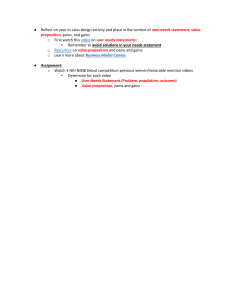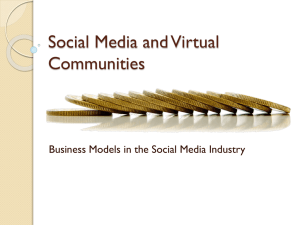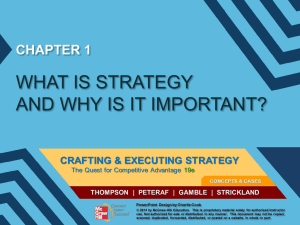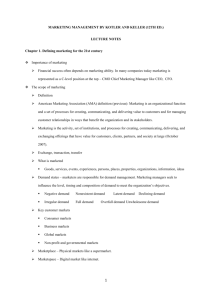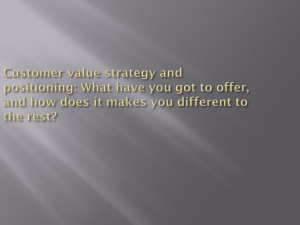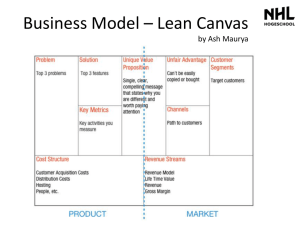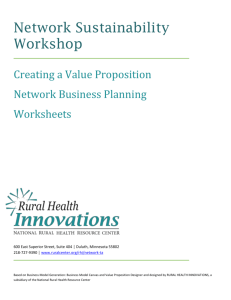Document
advertisement
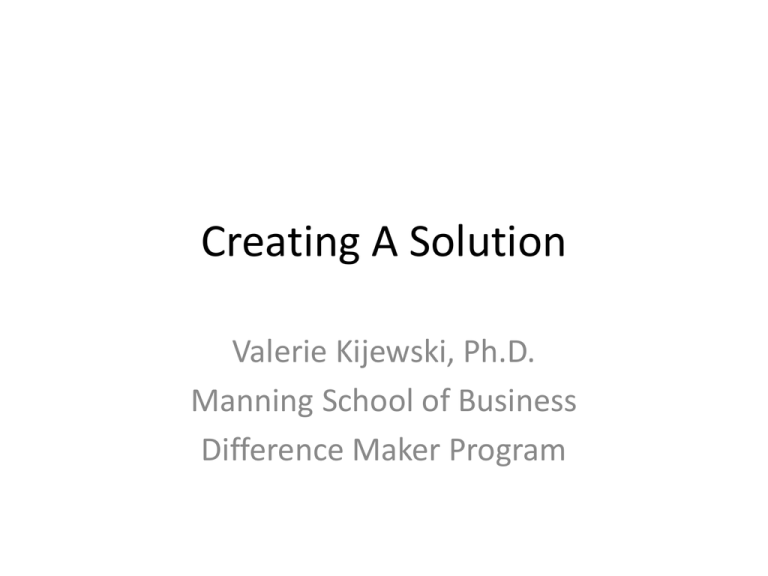
Creating A Solution Valerie Kijewski, Ph.D. Manning School of Business Difference Maker Program So Far, You Have… • Defined the Problem your Team is Solving – Problem Statement – Who is affected by problem? – How are they affected by problem? – Why is it important to solve this problem? • Assessed the Opportunity – Who currently addresses this problem? – How is the current solution delivered? – How effective is the current solution? – What can be improved? Alternative approach? Now We Discuss Value • Customer Value – Including patients, clients, customers – The groups who are affected by the problem • Business Value – How you will operationalize your solution – How you will support/sustain your solution Question Addressed Today • What part of the problem are you trying to solve? • What value do you deliver to the affected group? • What are the costs / revenues associated with your solution? • How will you sustain your solution? It Takes A Community . . . You must build a sustainable organization to help solve real-world problems and provide value to constituents (customers) over time. What Is A Business Model? A business model describes the rationale of how an ORGANIZATION creates, delivers, and captures value. The Business Model Let’s go to the movies . . . http://www.businessmodelgeneration.com/canvas Business Model KEY PARTNER KEY ACTIVITIES KEY RESOURCES COST CENTRES Value Proposition RELATIONSHIPS CHANNELS REVENUE STREAMS CLIENTS Canvas Building Website http://www.canvanizer.com http://canvanizer.com/canvas/BAdYUoh xD2o Start-Ups Student Name: Derek Coleman Business Description: University Transportation service for students to travel to events safely Key Activities Create ecosystem to keep students on website, mobile, or marketing list Transport students safely, gain a good reputation Get feedback, improve Key Partners Bus companies Venues Value Proposition Atmosphere on the bus, reputation Universities Customer experience Key Resources Website Employees/legal team Cost Structure Cost more for trips with less people. Looking for $500 profit after all variable expenses. Customer Relationships Trustworthy, brand worthy Fun, exciting, good time Cheap, safe, caring Channels Transportation. (Safe, cheap, ff to events convenient) Website Customer Segments College students (who don’t have a ride or want to travel with friends + friends who they travel with Freshman On campus marketing Parents looking to keep their kids safe when going to events Social media accounts Socially responsible students Sign-up application Revenue Stream Money generated from trips. Preferably $500 profit per trip after COGS Selling booklets in advance for 10 trips that semester. Not-For Profit Model Key Partners Key Activities Customer Relationships Value Proposition Key Resources Donor Mission Channels Product or Service Recipient Free Cost Structure Customer Segments Revenue Stream Donation Lazarus House Ministry Inc. Key partnerships Key activities KA • • • • • • • Local &Corp. Businesses Charitable Foundation Individuals (Volunteers) Churches Social Enterprises Greater Lawrence Health Center Cost structure Fundraising Coordinator Admission Management Donor Management • • Key resources • • • • C$ Lazarus Locations Volunteers Staff Donated Items/monies • Administrative costs • Fundraising costs • Utility costs Value propositions • • • • Customer relationships Meals Shelter Counseling Health Care • • Community Members Personal Assistance Gains • Empowerment • A job • Permanent housing • Resources Pain Relievers • Diminishes concerns • Eliminating hunger • Donors? Customer segments • • People living in poverty (Recipients) Community Members • Donors Channels • CH Online donations (www.lazarushouse.org) • Thrift Shop • Good Shepherd’s Center • Lazarus Locations R$ Free • Donations • Fundraisers • Thrift Shop Sales Gains • Shelter • Meals • Community • Security • Work Prep Pains • Overcrowded shelters • Little privacy • Time constraints Revenue streams Critical Issue: Value Proposition – Customer Fit Key Partners Key Activities Key Resources Customer Relationships Value Proposition Channels Customer Segments Dynamically Interdependent Cost Structure Revenue Stream 14 Customer Discovery Process • Start with a vision (a solution to a problem) • Customer Discover process searches for problem/solution fit • Does your value proposition match customer segment it plans to target? • Develop the product for ‘the few’, not everyone • Get Market Feedback – Build a ‘minimum viable product’ (MVP) – Don’t add features without feedback! WHAT IS A VALUE PROPOSITION? Let’s Go Back to The Movies http://ecorner.stanford.edu/authorMaterialInf o.html;jsessionid=C88A82434C120C7FE39 B9D5ABDD0494A?mid=2877 Map Customer to Value Proposition Value Proposition Products Customer Segment Wins Results Gains JOB Services Features Pain Killers FIT To Be Pains DONE Getting The Customer Value Proposition Right Is Critical To Success Explore Customer Pain What does your customer find too costly? (e.g., too much time, too much money, requires substantial effort, …) What makes your customer feel bad? (e.g., frustrations, annoyances, . . .) How are current solutions underperforming for your customer? (e.g., lack of features, performance, malfunctioning, accuracy…) What negative social consequences does your customer encounter or fear? (e.g., loss of face, trust, power, status . . .) What’s keeping your customer awake at night? (e.g., big issues, concerns, worries . . .) What common mistakes does your customer make? (e.g., usage mistakes, inappropriate priorities . . .) What barriers are keeping your customers from adopting solutions? (e.g., upfront investment, learning curve, resistance to change . . .) 18 Explore Customer Gains Which savings would make your customer happy? (e.g., time, money, effort, risk . . .) What outcomes does the customer expect and what would go beyond expectations? (e.g., quality level, more or less or something . . .) How do current solutions delight your customer? (e.g., specific features, performance, quality . . .) How would you make your customer’s job or life easier? (e.g., flatter learning curve, more services, lower cost of ownership . . .) What positive social consequences does your customer desire? (e.g., makes them look good, increase in power or status . . .) What are customers looking for? (e.g., good design, guarantees, specific or more features . . .) What do customers dream about? (e.g., big achievements, big reliefs . . . ) How does your customer measure success or failure? (e.g., performance, cost . . .) What would increase the likelihood of adopting a solution? (e.g., lower cost, less investment, lower risk, better quality . . .) 19 Exercise: Customer 1. 2. List Pains List Gains Job To Be Done http://www.youtube.com/watch?v=s9n bTB33hbg&feature=player_embedded Customer Discovery Interview http://startupweekend.wistia.com/m edias/tao3s8hf7l Exercise A Day In The Life Of Your Customers Question Customer 1___________ Customer n____________ 1. How Is Your Customer Currently Dealing With This Task/Problem? 2. What Are They Trying To Accomplish? Desired Outcome? Wish They Could Do? 3. What Approach Are They Attempting 4. What Are The Interfering Factors? 5. What Are The Economic Consequences? –Costs? 23 A Day In The Life . . . Question Customer 1___________ Customer n____________ 6. Your New Approach . . . 7. Enabling Factors? 8 Economic Rewards? 9. Is Our Price Consistent With Budget? – Problem Solved? 24 How can I find customers before I’ve even built a product? How were you planning on finding them after you’ve built a product? 25 Finding People . . . • AdWords / Facebook Ads /Tweets – Summarize your idea – get it on search engines • Twitter Search – Search for people who discussed _____ • @username Would love yr feedback on [product/problem/solution] – shd only take 2mins [URL] thanks! • Google Alerts – Monitor the web for product/problem/solution • I read your [post/comment] about [product/problem/solution]. I’m currently trying to validate a related idea and I think your opinion would be very valuable to me – could you take 2 minutes and check out [URL]? Thank you – I’d be happy to return the favor any time. • LinkedIn to ask for Introductions 26 Customer Segments (Customer Archetype) Groups That Rank Importance Differently! Needs Amateur Camera Professional Camera Ease of Use Weight Lens Options Size Auto Focus Lesson: Customers Buy Your For Your Strengths – Business Model KEY PARTNER Who do we need to partner with? What do they bring to the table? - Access? -Efficiency? -Capabilities? -Credibility? KEY ACTIVITIES What must we do: -Better than comp. –Extremely well vs. outsource Value Proposition RELATIONSHIPS Customers How do we acquire customers? What? -Pain Killers - Gains given KEY RESOURCES What unique resources do we need/have? - IP - Information -Access -Skills COST CENTRES Cost Structure? Sustainable? - On-going full costs covered? - Fixed - Adequate cash flow (cigar box) - Variable What is Cost To acquire a customer or donor? Who? -Jobs to get done -Pains relieved -Gains sought CHANNELS How do we reach our clients? REVENUE STREAMS Revenue Sources? - One, Multiple? - Sustainable? Economics? -Break-even Volume -Cash Required? Go Build Your Initial Business Model (But Expect To Revise It Often As You Learn and Grow)
